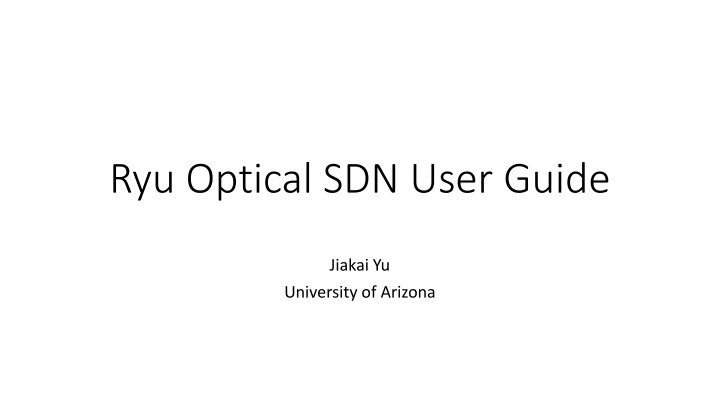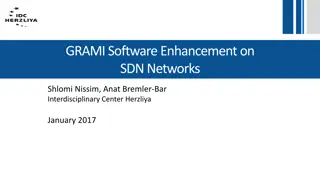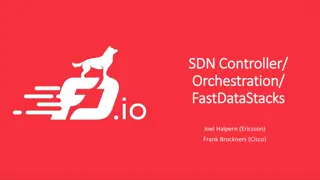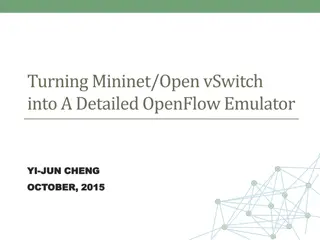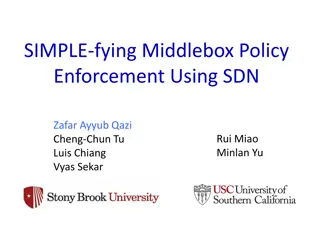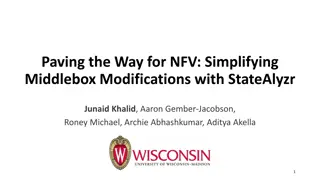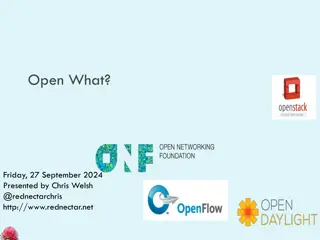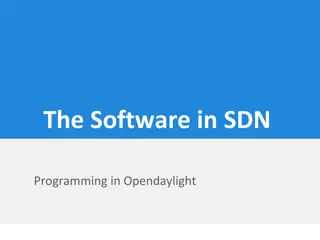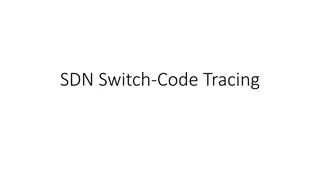Optical SDN/NFV User Guide for Network Control & Management
Explore the comprehensive user guide for Optical Software-Defined Networking (SDN) and Network Functions Virtualization (NFV) at the University of Arizona. Learn about the SDN controller interfaces, network monitoring, traffic engineering databases, and more. Discover the capabilities of the Northbound and Southbound Interfaces, JSON data formats, control logic with events, light-path setup with wavelength routing, and space switching for network reconfiguration.
Download Presentation

Please find below an Image/Link to download the presentation.
The content on the website is provided AS IS for your information and personal use only. It may not be sold, licensed, or shared on other websites without obtaining consent from the author.If you encounter any issues during the download, it is possible that the publisher has removed the file from their server.
You are allowed to download the files provided on this website for personal or commercial use, subject to the condition that they are used lawfully. All files are the property of their respective owners.
The content on the website is provided AS IS for your information and personal use only. It may not be sold, licensed, or shared on other websites without obtaining consent from the author.
E N D
Presentation Transcript
Ryu Optical SDN User Guide Jiakai Yu University of Arizona
Optical SDN/NFV SDN controller: Interfaces for users & devices Network monitoring Network control & management Path computation Database: Traffic Engineering Database (TED) for real- time computing with memory r/w PostgreSQL for data record with hard disk w/r
Optical SDN/NFV Optical Layer NFV: ROADM-WSS: NETCONF/YANG ROADM-EDFA: NETCONF/YANG Space switch: OpenFlow/SSH/Telnet Modules: WSS: Port setup, Cross-connection setup, Wavelength channel setup EDFA: Gain/Tilt adjustment, Gain mode selection, Constant gain/power Space switch: Cross-connection setup, Topology saving/loading Monitoring: ROADM and Space Switch
Northbound and Southbound Interface JSON data format { key : value , key : value } - WSGI is the northbound interface, using HTTP protocol and JSON data format for communication between users and SDN controller. Users - POST request event to SDN controller via JSON data format. HTTP JSON { request_type : request type , source_node_id : 1 , source_node_port : 3 , destination_node_id : 4 , destination_node_port : :3 , start_freq : 196825.25 , end_freq : 196875.25 , direction : uni-direction , username : admin , password : admin } port 8080 Web Server Gateway Interface (WSGI) Northbound Interface SDN controller core Southbound Interface - Southbound interface is using NETCONF protocol via ncclient package. NETCONF
Control Logic with Events Monitor Amplifier Configure Single ROADM Traffic Engineering Database (TED) Lumentum ROADM-20 Souhbound Interface Northbound Interface Configure MUX/DEMUX Monitor event Tear connection Multiple ROADMs Wavelength Routing Algorithm (RWA) Add connection
1. Light-path setup with wavelength routing assignment Operation types: Light-path setup Space switching Connection types: Lumentum ROADM Calient S320 SDN OLSP types: Protected Unprotected Main modules : TED/PostgreSQL Resource reservation RWA NOTICE: SDN OLSP is not the conventional LSP method. It is a labeled switched light-path used in SDN controller management.
2. Space switching for network topology reconfiguration with service availability detection
Python Coding Functions <nothbound_message_sending.py>, <northbound_message_receiving.py> Northbound Interface Control Logic <path_computation.py>, <intra_domain_connection.py> Wavelength Routing Algorithm (RWA) <path_computation.py>, <RWA_shortestpath_random.py> Traffic Engineering Database (TED) <database.py>, <initialization.py> , <common.py>, <init_files> <lumentum_NETCONF.py>, <calient_telnet.py> <southbound_message_receiving.py> Souhbound Interface <custom_event.py> Control Events
Request JSON format All JSON format requests should be sent to the SDN server set up on localhost:8080 (template use: send.py) Add a light-path through multiple ROADMs with RWA {"Request_Class": "AddPathConnection", direction": bi-direction", # bi-direction or uni-direction "source_node_ip": "10.104.1.4", "source_node_port": "1", # 20 ROADM ports, id 1-20 (only 4 connected to Calient) "destination_node_ip": "10.104.1.3", "destination_node_port": "1", "connection_name": "comsmos", "connection_id": 1", # 96 wavelength channels, id 1-96 "channel_id": 25", # 96 wavelength channels, id 1-96 "username": **", # Lumentum ROADM username "password": **"} # Lumentum ROADM password
Tear down a light-path through multiple ROADMs with RWA {"Request_Class": "TearPathConnection", "connection_id": "62", # target teardown connection id "direction": "bi-direction", # bi-direction or uni-direction "username": **", # Lumentum ROADM username password : **"} # Lumentum ROADM password Monitor WSS connection information of a ROADM {"Request_Class": "MonitorWSS", "node_ip": "10.104.1.1", # Target ROADM IP username : *", # Lumentum ROADM username # Lumentum ROADM password password : **"}
Configure a single ROADM WSS connection {"Request_Class": "ConfigWSS", "node_ip": "10.104.1.2", "name": "cosmos", "module_id": 2, # MUX and De-MUX, id 1 and 2 "connection_id": 1, # 96 channels, id 1-96, or all "input_port": 5101, # De-MUX input id 5101, MUX input id 4101 "output_port": 5203, # De-MUX output id 5201-5220, MUX output id 4201-4220 "start_freq": 194600.00, # WSS channel start frequency "end_freq": 194650.00, # WSS channel end frequency "attenuation": 4.0, # channel attenuation 0-20 dB "status": "in-service", # in-service or out-of-service "block": "false", # channel signal block status: true or false username : **", # Lumentum ROADM username password : **"} # Lumentum ROADM password
Monitor EDFA information of a ROADM {"Request_Class": "MonitorEDFA", "node_ip": "10.104.1.2", "username": **", "password": **"} Configure a ROADM EDFA {"Request_Class": "ConfigEDFA", "node_ip": "10.104.1.2", "module": 1, "ctrl_mode": "constant-gain", # control mode: constant-gain or constant-power "gain_mode": "high-gain", # gain mode: high-gain or low gain "target_power": -3, # target power value, if constant-power is enabled "target_gain": 23, # target gain value, if constant-gain is enabled "tilt": 0, # gain tilt value "ALS": False, # automatic laser shutdown: True or False "status": "in-service", # working status: in-service or out-of-service "username": **", "password": **"}
Set up cross-connections in Calient S320 {"Request_Class": "SetupCRS", "authentication": "***", # Calient authentication info "crs": ["5.7.6>5.8.5","5.7.7>5.8.6"]} # > is uni-direction, - is bi-direction Tear down cross-connections in Calient S320 {"Request_Class": "TeardownCRS", "authentication": "***", "crs": ["5.7.6>5.8.5","5.7.7>5.8.6"]} # > is uni-direction, - is bi-direction Get all cross-connections in Calient S320 {"Request_Class": "GetTopo", "authentication": "***"}
